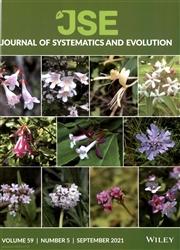异源四倍体棉花(Gossypium spp.)
IF 2.9
1区 生物学
Q1 Agricultural and Biological Sciences
引用次数: 0
摘要
棉花(棉属植物)是全球重要的可再生纤维来源,也是世界上最重要的经济作物之一。虽然人们已经探索了棉花的大量核基因组数据,但在群体水平上,异源四倍体棉花的细胞器基因组资源在很大程度上仍未得到开发。质体基因组(plastome)具有非重组单亲遗传性,非常适合研究植物物种关系和多样性。在此,我们对主要来自驯化栽培品种的 336 个格桑花质粒进行了从头组装,并生成了用于种群结构和遗传多样性分析的泛质粒级资源。组装的质粒表现出典型的四方结构,长度从 160 103 到 160 597 bp 不等。在物种水平上,7 个异源四倍体物种被分解为三个支系,其中 Gossypium tomentosum 和 Gossypium mustelinum 形成了以二倍体为根的早期分化支系,随后分裂出 Gossypium darwinii-Gossypium barbadense 和 Gossypium hirsutum-Gossypium ekmanianum-Gossypium stephensii 两个姐妹支系。在 G. hirsutum 支系中,与 G. barbadense 相比,栽培品种与陆地栽培品种和野生品系的多态性较低,这表明在驯化这一适应性强的棉花品种的过程中对质体进行了一些选择。G. hirsutum 的核苷酸多样性高于 G. barbadense。我们特别比较了 G. hirsutum 和 G. barbadense 的质体,以发现每个物种中作为潜在分子标记的突变热点。这些发现为探索棉花进化、培育棉花新品种以及保存野生和栽培种质提供了宝贵的资源。本文章由计算机程序翻译,如有差异,请以英文原文为准。
Genetic diversity and evolution of the plastome in allotetraploid cotton (Gossypium spp.)
Cotton (Gossypium spp.) is a vital global source of renewable fiber and ranks among the world's most important cash crops. While extensive nuclear genomic data of Gossypium has been explored, the organellar genomic resources of allotetraploid cotton, remain largely untapped at the population level. The plastid genome (plastome) is well suited for studying plant species relationships and diversity due to its nonrecombinant uniparental inheritance. Here, we conducted de novo assembly of 336 Gossypium plastomes, mainly from domesticated cultivars, and generated a pan‐plastome level resource for population structure and genetic diversity analyses. The assembled plastomes exhibited a typical quadripartite structure and varied in length from 160 103 to 160 597 bp. At the species level, seven allotetraploid species were resolved into three clades, where Gossypium tomentosum and Gossypium mustelinum formed an early diverging clade rooted by diploids, followed by splitting two sister clades of Gossypium darwinii –Gossypium barbadense and Gossypium hirsutum –Gossypium ekmanianum –Gossypium stephensii . Within the G. hirsutum clade the resolution of cultivated accessions was less polyphyletic with landrace and wild accessions than in G. barbadense suggesting some selection on plastome in the domestication of this adaptable species of cotton. The nucleotide diversity of G. hirsutum was higher than that of G. barbadense . We specifically compared the plastomes of G. hirsutum and G. barbadense to find mutational hotspots within each species as potential molecular markers. These findings contribute a valuable resource for exploring cotton evolution as well as in the breeding of new cotton cultivars and the preservation of wild and cultivated germplasm.
求助全文
通过发布文献求助,成功后即可免费获取论文全文。
去求助
来源期刊

Journal of Systematics and Evolution
Agricultural and Biological Sciences-Ecology, Evolution, Behavior and Systematics
CiteScore
7.40
自引率
8.10%
发文量
1368
审稿时长
6-12 weeks
期刊介绍:
Journal of Systematics and Evolution (JSE, since 2008; formerly Acta Phytotaxonomica Sinica) is a plant-based international journal newly dedicated to the description and understanding of the biological diversity. It covers: description of new taxa, monographic revision, phylogenetics, molecular evolution and genome evolution, evolutionary developmental biology, evolutionary ecology, population biology, conservation biology, biogeography, paleobiology, evolutionary theories, and related subjects.
 求助内容:
求助内容: 应助结果提醒方式:
应助结果提醒方式:


